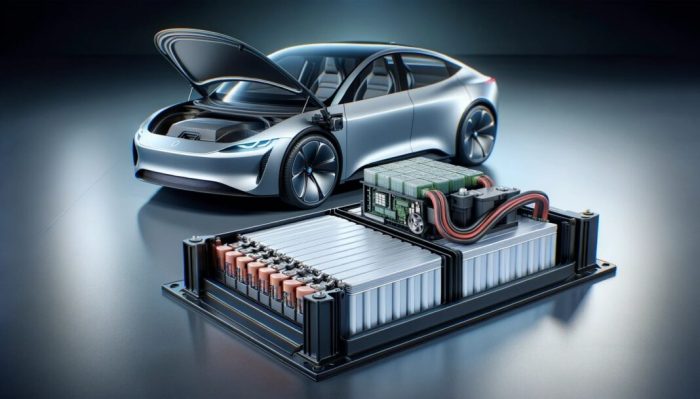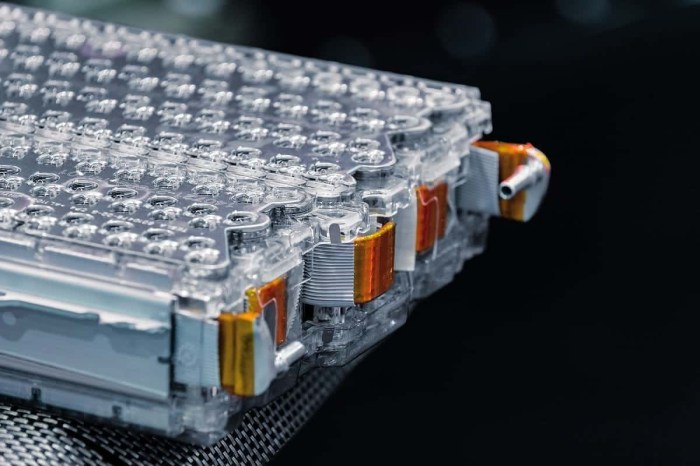Solid-state batteries in EVs 2025: Get ready for a revolution in electric vehicle technology! Forget range anxiety and slow charging times – the potential of solid-state batteries is poised to completely transform the EV landscape. We’re diving deep into the projected advancements in energy density, charging speeds, and safety, exploring the manufacturing challenges and market projections for this game-changing technology.
This isn’t just about better batteries; it’s about a future where EVs are truly competitive with gas-powered vehicles.
From breakthroughs in materials science to tackling the hurdles of mass production, we’ll unpack the key aspects that will determine the success of solid-state batteries in EVs by 2025. We’ll analyze the projected cost reductions, safety improvements, and environmental impact, painting a picture of what the future of electric mobility might look like.
Technological Advancements in Solid-State Batteries by 2025
By 2025, solid-state batteries are poised to significantly disrupt the EV market, offering substantial improvements over current lithium-ion technology. These advancements are driven by intense research and development, aiming to overcome the limitations of traditional batteries and deliver a superior driving experience. This section will detail the expected progress in several key performance areas.
Energy Density Improvements
Solid-state batteries are projected to achieve significantly higher energy densities than current lithium-ion batteries by 2025. This means more range on a single charge. For example, while a current high-performance lithium-ion battery might offer around 300 Wh/kg, solid-state batteries are expected to reach 400-500 Wh/kg, or even higher depending on the specific solid electrolyte and cathode materials used.
This improvement stems from the higher voltage capabilities and better packaging efficiency offered by the solid-state design. This translates to EVs capable of traveling significantly further distances before requiring a recharge, a major selling point for consumers.
Charging Speed and Cycle Life Advancements
Faster charging and longer lifespan are two critical areas where solid-state batteries are expected to excel. The solid electrolyte’s inherent stability allows for faster ion transport, leading to quicker charging times. While current lithium-ion batteries might take hours for a full charge, solid-state batteries could potentially achieve an 80% charge in under 15 minutes by 2025. Furthermore, the reduced degradation of the solid electrolyte translates to a significantly extended cycle life.
Where lithium-ion batteries might degrade noticeably after several hundred charge cycles, solid-state batteries are projected to maintain a higher percentage of their initial capacity after thousands of cycles, greatly increasing their overall lifespan and reducing the need for frequent battery replacements.
Materials Science Breakthroughs
The performance of solid-state batteries hinges heavily on advancements in materials science. Researchers are actively exploring various solid electrolytes, including sulfide-based, oxide-based, and polymer-based materials, each with its own advantages and disadvantages. For example, sulfide-based electrolytes offer high ionic conductivity but can be less stable in air, while oxide-based electrolytes exhibit better stability but lower conductivity. Significant breakthroughs in synthesizing and processing these materials are anticipated, leading to improved ionic conductivity, wider electrochemical windows, and enhanced stability.
Additionally, the development of high-capacity cathode materials, such as lithium-rich layered oxides, is crucial for maximizing energy density. These material advancements will be key to achieving the projected performance improvements.
Cost Reduction Strategies
One of the primary hurdles for widespread adoption of solid-state batteries is cost. However, several strategies are being pursued to reduce manufacturing costs by 2025. These include optimizing the manufacturing processes to improve efficiency and reduce waste, scaling up production to benefit from economies of scale, and exploring lower-cost materials without sacrificing performance. For instance, the development of less expensive solid electrolytes and the use of more abundant materials in the cathode and anode could significantly contribute to cost reduction.
Government subsidies and incentives also play a role in making solid-state batteries more competitive in the market.
Projected Performance Metrics Comparison
| Metric | Solid-State (2025 Projection) | Lithium-ion (Current) | Percentage Improvement |
|---|---|---|---|
| Energy Density (Wh/kg) | 450-500 | 250-300 | 80-100% |
| Charging Time (80%) | <15 minutes | >1 hour | |
| Cycle Life (Capacity Retention at 80%) | >3000 cycles | 500-1000 cycles | |
| Cost ($/kWh) | $150-$200 (projected reduction) | $100-$150 |
Manufacturing and Scalability Challenges

Solid-state batteries hold immense promise for revolutionizing electric vehicles, offering higher energy density, faster charging, and improved safety compared to their lithium-ion counterparts. However, translating this potential into mass production and widespread adoption faces significant manufacturing and scalability hurdles.
These challenges stem from material science, manufacturing processes, and supply chain complexities. Overcoming them is crucial for realizing the full benefits of solid-state technology in the EV market by 2025.The primary obstacles hindering mass production are multifaceted. Current manufacturing processes are not optimized for the unique characteristics of solid-state battery components. Scaling up production while maintaining quality and cost-effectiveness presents a considerable technological challenge.
Furthermore, the supply chain for critical raw materials requires significant improvements to ensure sufficient and reliable access to these materials.
Technological Hurdles in Scaling Manufacturing
Efficient and cost-effective scaling of solid-state battery manufacturing requires advancements in several key areas. The delicate nature of solid electrolytes necessitates precise and controlled manufacturing processes to prevent defects that can compromise performance and safety. Current production methods, often adapted from lithium-ion battery manufacturing, are not ideally suited for the unique requirements of solid-state electrolytes and their integration with other components.
This results in lower yields, increased production costs, and longer production times. For example, the high-temperature processing often needed for some solid-state battery components can lead to material degradation and increased energy consumption. Developing innovative, low-temperature, and high-throughput manufacturing techniques is paramount to achieving cost-effective mass production.
Raw Material Supply Chain Constraints
The availability and cost of raw materials represent a significant challenge to the scalability of solid-state battery production. Solid-state batteries often rely on materials such as lithium, nickel, cobalt, manganese, and specialized solid electrolytes that may not be readily available in sufficient quantities or at competitive prices. This scarcity can lead to price volatility and potential supply chain disruptions.
Furthermore, the geographical distribution of these materials can create logistical complexities and geopolitical risks. For instance, the dominance of a few countries in the supply of certain critical minerals can lead to price manipulation and supply bottlenecks.Potential solutions include diversifying sourcing, investing in exploration and mining of new resources, and developing alternative materials that are more abundant and less geopolitically sensitive.
Solid-state batteries are poised to revolutionize EVs by 2025, offering faster charging and increased range. But the overall cost savings will depend heavily on electricity prices, which is why checking out this comparison of EV charging cost per mile vs gas in 2025 is crucial. Ultimately, the widespread adoption of solid-state batteries will hinge on both technological advancements and economic factors like charging costs.
Recycling strategies are also crucial for reducing reliance on primary resources and mitigating environmental impact. The development of closed-loop recycling systems specifically designed for solid-state battery components can help secure a sustainable supply of critical raw materials. This also helps to mitigate environmental concerns related to mining and processing.
Solid-State Battery Manufacturing Process Flowchart
The following describes a simplified flowchart of the solid-state battery manufacturing process, highlighting critical steps and potential bottlenecks:
1. Raw Material Acquisition and Processing
This step involves sourcing and purifying the necessary raw materials, including lithium, cathode materials, anode materials, and solid electrolyte precursors. Potential bottlenecks include supply chain disruptions and the energy intensity of material processing.
2. Solid Electrolyte Synthesis
This crucial step involves the synthesis and processing of the solid electrolyte material. Precise control over the synthesis process is essential to achieve the desired properties of the electrolyte. Challenges include achieving high ionic conductivity, preventing cracking or short circuits, and scaling up production to meet demand.
3. Electrode Fabrication
This involves mixing the active materials (cathode and anode) with the conductive additives and binders, followed by coating the active material onto a current collector. Challenges include achieving uniform coating, ensuring good contact between the active materials and the electrolyte, and maintaining consistent quality across large-scale production.
4. Cell Assembly
This step involves carefully assembling the electrodes and solid electrolyte into a complete battery cell. Precise alignment and pressure control are critical to ensure good contact and prevent defects. Challenges include ensuring consistent and reliable cell assembly at high speeds and maintaining high yields.
5. Cell Testing and Quality Control
This step involves testing the assembled cells to ensure they meet performance and safety standards. Rigorous quality control is crucial to identify and eliminate defective cells before they enter the market. Challenges include developing efficient and reliable testing methods and maintaining consistent quality across large-scale production.
6. Packaging and Distribution
This final step involves packaging the tested cells and distributing them to end-users. Challenges include ensuring safe and efficient transportation and storage of the cells.
Safety and Reliability of Solid-State Batteries in EVs
Solid-state batteries (SSBs) are generating significant excitement in the EV industry, largely due to their potential for enhanced safety and performance compared to traditional lithium-ion batteries (LIBs). However, understanding the nuances of their safety profile and reliability is crucial for widespread adoption. This section delves into the inherent safety features, potential risks, and mitigation strategies associated with SSBs in electric vehicles.
Comparison of Inherent Safety Features
Solid-state batteries offer several inherent safety advantages over LIBs. The most significant difference lies in the electrolyte. LIBs utilize a liquid or polymer gel electrolyte, which is flammable and can leak, leading to short circuits and thermal runaway. SSBs, on the other hand, employ a solid electrolyte, typically a ceramic or sulfide-based material. This solid electrolyte is non-flammable and less prone to leakage, significantly reducing the risk of fire and explosion.
Furthermore, the solid electrolyte’s higher ionic conductivity at elevated temperatures can contribute to improved thermal stability. While LIBs can experience rapid temperature increases during failure, leading to catastrophic events, the inherent characteristics of the solid electrolyte in SSBs offer a buffer against these runaway reactions. This enhanced thermal stability is a key factor in improving the overall safety profile.
Potential Risks and Mitigation Strategies Associated with SSB Failure
Despite their inherent advantages, SSBs are not without potential risks. One concern is the possibility of dendrite formation, where lithium metal deposits grow across the solid electrolyte, potentially causing short circuits. This risk is particularly relevant in high-power applications where rapid charging is required. Mitigation strategies include optimizing the electrolyte composition and microstructure to inhibit dendrite growth, as well as implementing advanced battery management systems (BMS) to monitor the battery’s health and prevent overcharging.
Another potential risk is the mechanical degradation of the solid electrolyte under repeated charge-discharge cycles. This can lead to cracks and internal short circuits. Researchers are actively investigating ways to improve the mechanical strength and durability of solid electrolytes through material modifications and improved cell designs. For example, the use of composite solid electrolytes or the incorporation of flexible components can improve resilience against mechanical stress.
Thermal Stability and Flammability Characteristics
The thermal stability of SSBs is significantly superior to that of LIBs. The non-flammable solid electrolyte eliminates the risk of electrolyte combustion, a major contributor to thermal runaway in LIBs. SSBs typically exhibit a higher thermal stability window, meaning they can withstand higher temperatures before undergoing thermal runaway. This increased thermal stability reduces the likelihood of fire or explosion, even under abusive conditions such as overcharging or physical damage.
However, it is important to note that while less likely, thermal runaway can still occur in SSBs, particularly if there is a significant internal short circuit or external damage that compromises the integrity of the solid electrolyte. Extensive testing and rigorous safety standards are necessary to ensure the safe operation of SSBs in EVs. Furthermore, careful consideration of cell design and materials selection is crucial for maximizing thermal stability.
Key Safety Certifications and Standards Anticipated by 2025
By 2025, we anticipate a robust set of safety certifications and standards specifically tailored for solid-state batteries will emerge. These standards will likely encompass aspects such as thermal stability testing, mechanical integrity testing, and electrical safety testing, exceeding the existing standards for LIBs. The standards will be developed by organizations such as UL, IEC, and other relevant regulatory bodies.
Specific tests may include those measuring the battery’s response to high temperatures, puncture tests, and overcharge tests. The development and implementation of these standards will be crucial in ensuring the safe and reliable deployment of SSBs in EVs and building consumer confidence. These certifications will provide a baseline of safety performance and reliability for manufacturers and consumers alike, promoting responsible innovation and widespread adoption of this promising technology.
Examples of anticipated standards include updated versions of existing automotive battery safety standards, with additional requirements for solid-state specific characteristics. Furthermore, new standards might address the unique challenges posed by solid-state battery manufacturing processes.
Integration and Application in Electric Vehicles
Solid-state batteries represent a significant leap forward in EV technology, promising improvements across the board. Their successful integration, however, requires careful consideration of existing EV architectures and a thorough understanding of their unique characteristics. This section will explore the design considerations, performance impacts, cost implications, and lifecycle effects of integrating solid-state batteries into electric vehicles.Solid-state battery integration into existing EV architectures necessitates a rethinking of several design elements.
The physical dimensions and form factor of solid-state batteries differ from traditional lithium-ion cells. This means adapting existing battery pack designs, thermal management systems, and even the chassis layout to accommodate these changes. For instance, the rigid nature of solid-state batteries might require modifications to the battery pack casing to better manage stress and strain during operation and charging cycles.
Furthermore, the higher energy density of solid-state batteries could allow for smaller battery packs, opening up possibilities for more creative vehicle designs with greater interior space or improved aerodynamics.
Design Considerations for Solid-State Battery Integration
The integration of solid-state batteries presents unique challenges compared to lithium-ion batteries. The higher energy density allows for smaller, lighter battery packs, but requires careful consideration of cell packaging and thermal management. The different mechanical properties necessitate changes in the battery pack design to accommodate potential stress and strain during vehicle operation. For example, the use of advanced composite materials in the battery pack casing might be necessary to ensure structural integrity and safety.
Moreover, the interface between the battery cells and the battery management system (BMS) needs to be optimized for efficient energy transfer and monitoring. Innovative approaches in thermal management are also crucial, considering the unique thermal properties of solid-state batteries. The overall design must prioritize safety, ensuring robust protection against potential short circuits or thermal runaway.
Impact of Solid-State Battery Characteristics on EV Range, Performance, and Weight, Solid-state batteries in EVs 2025
Solid-state batteries are expected to significantly impact EV range, performance, and weight. Their higher energy density translates directly to a longer driving range on a single charge. For example, a hypothetical EV using a solid-state battery pack could achieve a range exceeding 500 miles, compared to the current 300-mile average for many high-end EVs using lithium-ion batteries. This improvement comes with potential weight reduction, as the smaller, more energy-dense solid-state pack can achieve the same energy capacity with less mass.
This weight reduction could enhance vehicle acceleration and overall performance, potentially reducing 0-60 mph times. The improved efficiency also leads to reduced energy consumption per mile driven, further enhancing the range.
Projected Cost of Solid-State Battery Integration Compared to Lithium-Ion Systems
Currently, the cost of solid-state battery production is significantly higher than that of lithium-ion batteries. However, projections indicate a cost reduction as manufacturing techniques improve and economies of scale are realized. While precise cost comparisons are difficult to predict definitively due to ongoing technological advancements and fluctuating material prices, some analysts estimate that solid-state battery packs could reach price parity with lithium-ion systems within the next decade.
This would be driven by increased manufacturing efficiency, lower material costs, and higher production volumes. The initial high cost might limit early adoption to higher-end EV models, but mass production is expected to drive down prices considerably.
Impact of Solid-State Battery Adoption on the Overall Lifecycle Cost of EVs
The higher initial cost of solid-state batteries needs to be weighed against their potential long-term benefits. Their improved lifespan and durability could lead to lower replacement costs over the vehicle’s lifetime. Furthermore, the increased range and efficiency could result in reduced electricity consumption and lower operating costs. For instance, a reduced need for frequent charging could translate to significant savings on electricity bills over several years.
While the upfront investment might be higher, the potential for lower maintenance and operational costs over the vehicle’s lifecycle suggests that solid-state batteries could ultimately reduce the total cost of ownership for EVs. The longer lifespan could also reduce the environmental impact associated with battery disposal and recycling.
Market Projections and Adoption Rates: Solid-state Batteries In EVs 2025
Predicting the market penetration of solid-state batteries in EVs by 2025 is tricky, given the rapidly evolving technological landscape. However, by analyzing current trends and projections from industry experts, we can paint a reasonable picture of the near-future market. While widespread adoption by 2025 is unlikely, significant progress and initial market penetration are anticipated.Solid-state battery technology is still relatively nascent, facing challenges in manufacturing scalability and cost reduction.
Solid-state batteries are poised to revolutionize EVs in 2025, offering increased range and safety. But the upfront cost might be a hurdle for some buyers, which is where thinking about financing comes in. Check out the options available for managing that expense by looking at EV battery leasing options 2025 to see if it’s a good fit for you.
Ultimately, the impact of solid-state batteries on EV adoption will depend on factors like price and accessibility.
Therefore, the rate of adoption will depend on several interconnected factors, including technological breakthroughs, regulatory support, and consumer demand. Different EV segments – from luxury vehicles to mass-market models – will likely experience varying adoption rates based on price sensitivity and performance requirements.
Key Players and Strategies
Several major players are actively investing in solid-state battery technology, each employing unique strategies. Toyota, for instance, has been a long-term investor and is focusing on all-solid-state batteries for its hybrid and electric vehicles, aiming for mass production by the mid-2020s. Solid Power, a US-based company, is collaborating with Ford and BMW, emphasizing a layered approach to manufacturing and development.
Other notable players include Samsung SDI, LG Energy Solution, and CATL, each with their specific R&D focuses and strategic partnerships. These companies’ strategies range from internal development and manufacturing to collaborations and joint ventures, reflecting the complexities and high capital investment required in this emerging technology.
Factors Influencing Adoption Rates in EV Segments
The rate of solid-state battery adoption will vary across different EV segments. Luxury electric vehicle (EV) manufacturers might be early adopters, willing to pay a premium for the potential performance advantages, such as increased energy density and faster charging. Conversely, mass-market EV segments are likely to be more price-sensitive, requiring significant cost reductions before widespread adoption becomes feasible.
Government regulations and incentives will also play a crucial role, potentially accelerating adoption through subsidies and emission standards. Consumer perception and trust in the technology’s safety and reliability will also be important factors, with early adopters helping to build consumer confidence.
Projected Market Share by Geographic Region (2025)
A bar chart visualizing projected market share would show a relatively small but growing presence of solid-state batteries in the overall EV market by 2025. While precise figures are difficult to predict, we can illustrate a potential scenario. For example, Asia (particularly China, Japan, and South Korea) might hold the largest share due to significant investments in battery technology and a large EV market.
North America and Europe would likely follow, with slower adoption rates influenced by factors such as manufacturing capacity and regulatory landscapes. The chart would visually represent these regional differences, emphasizing the uneven distribution of market share. Imagine a bar chart with four bars representing Asia, North America, Europe, and Rest of World. Asia’s bar would be the tallest, representing approximately 45% market share, followed by North America at 25%, Europe at 20%, and the Rest of World at 10%.
This is a hypothetical illustration, and the actual figures may differ based on various unforeseen factors.
Environmental Impact and Sustainability

Solid-state batteries hold immense promise for the future of electric vehicles, but their environmental impact and sustainability must be carefully considered alongside their technological advantages. A comprehensive lifecycle assessment, encompassing material sourcing, manufacturing, usage, and end-of-life management, is crucial for determining their overall environmental footprint compared to current lithium-ion batteries.The environmental footprint of solid-state battery production differs significantly from that of lithium-ion batteries in several key areas.
While both rely on lithium, a resource with its own environmental concerns, solid-state batteries often utilize different cathode materials and electrolytes, leading to altered energy consumption during manufacturing and different waste streams. The elimination of flammable liquid electrolytes in solid-state batteries is a significant advantage, reducing the risk of hazardous chemical spills and improving overall safety during production and transportation.
However, the manufacturing processes for some solid-state battery components, such as solid electrolytes, might require higher energy inputs or generate different types of waste compared to lithium-ion battery production. A detailed comparative analysis using life cycle assessment (LCA) methodologies is needed to fully quantify these differences.
Comparison of Environmental Footprints
The environmental impact of solid-state battery production is currently a subject of ongoing research. Studies comparing the life cycle greenhouse gas emissions (GHGs) of solid-state and lithium-ion batteries are still limited. However, preliminary findings suggest that the overall GHG emissions could be lower for solid-state batteries due to the reduced use of certain resource-intensive materials and potentially improved energy efficiency in manufacturing.
For example, some solid-state battery designs utilize less cobalt, a metal associated with significant environmental and social concerns in its mining and processing. However, the use of alternative materials may introduce other environmental challenges. Further research and data are needed to provide a comprehensive and conclusive comparison.
Sustainability Challenges in Material Sourcing and Disposal
The sustainability of solid-state batteries is significantly impacted by the sourcing and disposal of their constituent materials. While lithium remains a critical component, the reliance on other materials, such as sulfur, various metal oxides, and the solid electrolytes themselves, introduces new challenges. Sourcing these materials responsibly, minimizing environmental damage during extraction and processing, and ensuring fair labor practices throughout the supply chain are crucial for the long-term sustainability of the technology.
The disposal of solid-state batteries also poses unique challenges. The complexity of their composition and the potential presence of hazardous materials necessitate the development of effective and environmentally sound recycling and reuse processes. Current lithium-ion battery recycling infrastructure will likely require significant adaptation to accommodate the unique characteristics of solid-state batteries.
Potential for Recycling and Reuse
Recycling and reuse of solid-state batteries are essential for minimizing their environmental impact. The development of efficient and cost-effective recycling processes is crucial for recovering valuable materials and preventing the accumulation of hazardous waste. The complexity of solid-state battery designs, however, presents challenges for conventional recycling methods. Research into innovative recycling techniques, such as hydrometallurgy or direct reuse of certain components, is ongoing.
Successful recycling will require collaborative efforts between battery manufacturers, recyclers, and policymakers to establish efficient collection systems, develop appropriate recycling technologies, and create regulatory frameworks that incentivize recycling and discourage illegal dumping. The potential for reuse of certain components, such as the current collectors, is also being explored, offering an alternative pathway for reducing waste and resource consumption.
Potential for Reducing Carbon Emissions in EV Lifecycles
The potential for reducing carbon emissions associated with the entire lifecycle of EVs using solid-state batteries is significant. While the manufacturing process might have a different environmental footprint compared to lithium-ion batteries, the potential for increased energy density and improved vehicle efficiency could lead to lower overall emissions during the vehicle’s operational phase. Longer battery lifespan, resulting from improved durability and safety, could also contribute to reduced overall carbon emissions by extending the time between battery replacements.
Furthermore, the reduced reliance on certain resource-intensive materials could potentially minimize the environmental impact associated with material sourcing and processing. The overall impact will depend on the specific battery chemistry, manufacturing processes, and vehicle design. Life cycle assessments considering all these factors are necessary to accurately quantify the potential for carbon emission reduction.
Last Word

By 2025, solid-state batteries could be the key to unlocking the full potential of electric vehicles. While challenges remain in manufacturing and scaling production, the projected advancements in energy density, charging speed, and safety are undeniably exciting. The potential for increased EV adoption, reduced environmental impact, and a more sustainable transportation future hinges on the successful integration of this revolutionary technology.
The race is on, and the future of EVs is electric – and potentially, solid-state.









